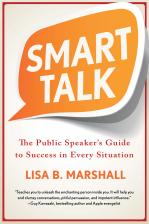How to Craft a Memorable Catchphrase
A memorable catchphrase can be the difference between sccess and failure in a presentation, speech, or even your business. The Public Speaker shares the latest research on phrase memorability and offers great tips for creating your perfect presentation mantra.
Lisa B. Marshall
Listen
How to Craft a Memorable Catchphrase
-
“Start with why.”
-
“People don’t buy what you do, they buy why you do it.”
-
“Development is evolutionary, not revolutionary.”
In an earlier episode called Why Everyone Needs a Good Catchphrase, I used these examples to show why a well-built catchphrase, or mantra, is a public speaker’s best friend..
In today’s episode we’ll look at what research tells us about memorable phrases and discuss the key elements of a well-crafted mantra.
What Makes a Catchprase Memorable?
Last year, researchers from the Department of Computer Science at Cornell University published a paper titled “You Had Me at Hello: How Phrasing Affects Memorability.”opens PDF file The goal of this study was to understand what information gets retained by the public and why. They looked at how phrasing (that is, sentence structure and word choice) impacts information retention.
The researchers created an analysis framework that allowed them to look at a broad set of movie quotes where some were memorable and some were not. They found major differences between quotes that stick with us and those that don’t.
What were some of the differences they discovered? Turns out, there are 6 key components of catchphrases that stick with us. They typically:
-
Use distinctive words. Memorable quotes are more distinctive than non-memorable quotes. Research showed that the less likely a phrase was to show up in “common language,” the more memorable it was.
-
Use common syntax. You might think non-traditional sentence structure would make a phrase stand out. But the data showed that simple, common syntax (the type of language used in everyday speech), is more memorable.
-
Can be used in a different context. Memorable catchprases use phrasing that can stand alone. They phrases aren’t tied to the content they’re introduced with.
-
Avoid personal pronouns. Since personal pronouns usually refer back to a specific person mentioned earlier in the talk, the phrase won’t make sense without it. It’s ok to use the second person pronoun “you” because it’s generic and not referring to a specific individual.
-
Use present tense verbs. Past tense verbs usually point back to a previous event so they don’t work well in a phrase that needs to stand alone. Use present tense verbs to create a memorable mantra.
-
Use more front-of-the-mouth sounds, like the letter “L” and less back sounds, like the letter “U.”
One word of caution here: While I do think this research is useful, it is certainly possible to overthink this. My advice is to come up with a few ideas first, then you can apply these findings to help fine-tune it. But I wouldn’t lose sleep over the fact that your new mantra uses more “U” sounds than “L” sounds.
4 Tips for Creating Memorable Catchprases
Here are 4 more catchphrase tips from Jeremy Donovan, author of the book How to Deliver a TED Talk and from my own experience.
-
Limit your phrase to 12 words or fewer, ideally 8. I mentioned this in my first episode on catchphrases, but it’s worth repeating. Spend some time looking at famous catchphrases and count how many words they include. Anything over 12 will be difficult for your audience to retain and repeat. Short phrases such as President Obama’s “Yes we can” or Nike’s “Just do it” are easy to remember and reusable in many different contexts.
-
Keep it action-centric. If you can give your audience something to do in your mantra, it will stick better. “Start with why” is an actionable mantra. So is Steve Jobs’ “Stay hungry, stay foolish.”
-
Use rhyming words or a sing-song style to make it stick. The catchier the phrase, the more likely people are to repeat it. I showed you a couple of examples of this in Why Everyone Needs a Good Catchphrase. A very famous one that I’m sure you’ll recognize is Johnny Cochran’s “If it doesn’t fit, you must acquit.”
-
Use uncommon figures of speech, like chiasmus. In an earlier episode I introduced you to some uncommon figures of speech that can really spice up your public speaking. I explained the concept of “chiasmus.” Chiasmus means using the same phrase in reverse order to make your point. Here’s an example of chiasmus that I created:
“Smart Talk is not just saying things right; Smart Talk is saying just the right things!”
Probably the most famous use of chiasmus to create a mantra comes from President John F. Kennedy:
“Ask not what your country can do for you – ask what you can do for your country.”
A more humorous example of chiasmus in a catchphrase comes from comedian Joey Adams:
“Never let a fool kiss you or a kiss fool you.”

This is Lisa B. Marshall, Helping you maximize sales, manage perceptions, and enhance leadership through keynotes, workshops, books, and online courses. Passionate about communication; your success is my business. If you want even more success in your life, I invite you to read my latest book, Smart Talk and listen to my other podcast, Smart Talk: Inspiring Conversations with Exceptional People.
Memorable graphic courtesy of Shutterstock.

